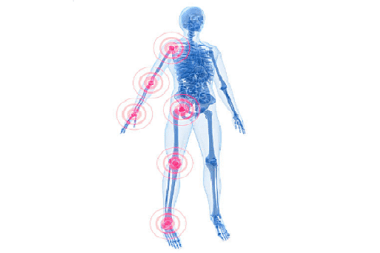Musculoskeletal system >>>> The mechanism of occurrence and causes of gout
The mechanism of occurrence and causes of gout.

Gout disease begins as a result of metabolic disorders associated with the formation and breakdown of uric acid. The source of uric acid entering the body is purine compounds that come with food and are formed as a result of endogenous synthesis. Foods rich in purine compounds include meat, fish, coffee, tea, yeast.
Uric acid is the result of the breakdown of purine compounds, entering the bloodstream in the form of sodium urate, it is excreted by the kidneys. Normally, the volume of excretion (excretion) of uric acid from the body per day should be equal to the volume of its entry into the blood. But if this does not happen, then excess uric acid is formed, the concentration of which in the blood increases. When using the reduction method or direct photometry to measure the level of sodium urate in the blood serum, it is possible to establish whether the uric acid concentration is normal or hyperuricemia (increased concentration of sodium urate) is observed.
The norm for women is 0.24 mmol / liter (no more than 0.36 mmol / liter);
The norm for men is 0.3 mmol / liter (no more than 0.42 mmol / liter).
If the results of the analysis go beyond the above indicators, then there is a risk of developing gout .
The causes of gout lie in the independent existence or combination of several factors associated with the formation and elimination of uric acid from the body:
Genetic disorders in the exchange of purines due to:
- Increased synthesis of purines by the body itself (endogenous disorders),
- Low uric acid clearance,
- Both types of violation are present.
- Low level of glomerular filtration or renal tubular excretion of sodium urate.
- An increased intake of purines from food alone or in combination with an endogenous increase in purine synthesis.
- Disturbances in enzymatic activity associated with a lack in the body of an enzyme that controls the synthesis of nucleotides from purines. In this case, not all purine compounds are involved in biochemical processes, and the excess goes to the formation of uric acid.
- Renal failure resulting in impaired tubular urate reabsorption and / or glomerular filtration. In some cases, the kidneys are not able to compensate for the load with the need for increased filtration and tubular excretion of sodium urate.
Medicines can cause hyperuricemia :
- Caffeine, methyl caffeine, theophylline, theobromine and their derivatives (diuretin) are purine compounds.
- Diuretics increase the concentration of uric acid, according to scientists, suppressing the process of excretion of urate by the tubules against the background of a decrease in intracellular fluid.
- Acetylsalicylic acid (and other salicylates) in small doses tend to increase the concentration of uric acid, while in large doses (from 4 to 5 grams per day) they reduce.
- Fatty foods, alcoholic beverages help block the renal excretion of sodium urate.
- Stress loads, dehydration, intoxication with heavy metal vapors, hypertension, hyperglyceridemia, psoriasis, myxedema, diabetes mellitus inhibit tubular excretion and interfere with the excretion of uric acid from the body.
Prolonged hyperuricemia, which is not compensated for by the body due to genetic disorders or acquired diseases of the urinary system, leads to the ingress of sodium urates into the synovial fluid (this is a compensatory way of the body that eliminates excess uric acid in the blood). The synovial fluid facilitates the entry of urates into the cartilage and synovium, where they crystallize. With defects in cartilage tissue, urate crystals enter the subchondral bone plate, destruct the bone substance (form tophuses ). Outwardly, tophuses look like bumps located around the joint.
In addition to the synovial fluid, excess uric acid penetrates into the structures of the skin, ligaments, kidneys and other organs, crystallizing there and forming microtofuses.
Sodium urates are found in the parenchyma of the kidney in the form of clusters of crystals, in the renal pelvis in the form of calculi (urate stones). This is how renal nephropathy (gouty kidney), urolithiasis, renal failure, nephrogenic hypertension and, as a consequence, heart failure, heart attack and often death develop.

Read

Read



























